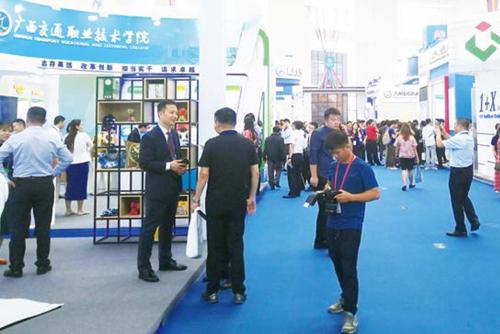China and ASEAN Should Strengthen Cooperation in Vocational Education and Release the Demographic Dividend in the Region
2019-11-18XuJunhaoTranslatedZhouHe
Xu Junhao Translated Zhou He

Over the years, the Chinese government has been committed to building a China-ASEAN community for the development of vocational education, and has made new progress and achievements. At present, nine state-level China-ASEAN vocational education talent training centers have been established, and China-ASEAN Border Vocational Education Alliance and other platforms have been built to help ASEAN countries and countries along the Belt and Road to train a large number of technical talents. At present, more than 39,000 students from ASEAN countries are studying in China. Also, China has sent thousands of volunteer teachers of teaching Chinese as a second language to teach in ASEAN countries. Against this background, at the 2019 China-ASEAN Vocational Education Summit Forum held during the 16th China-ASEAN Expo (CAEXPO), political and business guests from ASEAN countries indicated that there is still room for further expansion of China-ASEAN cooperation in vocational education.
Vigorously developing vocational education: China and ASEAN meeting each other halfway
“The skills of the workforce must match the needs of the economy in the future,” guests from ASEAN countries frequently expressed this view in their speeches. With a population of more than 600 million, almost every country in southeast Asia has been experiencing an unprecedented demographic dividend. Among them, the most representative one is Indonesia. Among its population of over 200 million people, 44% of young people are able to work, which makes Indonesia one of the most favored countries for foreign investment in the world.
However, the release of the demographic dividend not only requires a considerable number of workers, but also requires continuous improvement in the quality of workers, thus to improve productivity and purchasing power.
The Lao Deputy Minister of Education and Sports Kongsy Sengmany expressed in his speech that one of the biggest problems in Lao development was the gap between vocational education and the needs of the local economy.
“Since human resources are a bottleneck for Myanmars development, many local companies are unable to remain competitive in the international market,” said Sai Parn Seng, Minister of Shan Ethnic Affairs of Mandalay Region Government of Myanmar.
Therefore, it is urgently needed for ASEAN countries to vigorously develop vocational education. “To expand the market share, ASEAN countries with unbalanced development must try to bridge the development gap between different countries. To do this, it is inevitable to fill the gap in education,” said Kongsy Sengmany.
“Vocational education has become a crucial part of Myanmar Sustainable Development Plan (2018-2030), and the department of vocational education is working to make education available to every citizen. Myanmar is very fortunate to work with China in this process,” said Sai Parn Seng.
Similarly, in China, vocational education has also ushered in unprecedented opportunities for development. The aim of “improving the vocational education and training system, and deepening the integration of industry and education, and the cooperation between school and enterprise” was written into the report of 19th NCCNPC and CPPCC in 2018. In March 2019, Chinese Premier Li Keqiang first mentioned in his government work report that China would expand the enrollment of 1 million higher vocational colleges in 2019 so that more young people could realize their life value with their professional skills.
That is to say, specific to Chinas Guangxi, it would be a representative sample of Chinas development environment. “Due to the influence of population, industrial structure adjustment and the trend of scientific and technological development, the demand for vocational education and high-quality technical personnel in Guangxi today is more urgent than in the past 20 or 30 years,” said Huang Junhua, Vice Chairman of Guangxi Zhuang Autonomous Region.
How to deepen China-ASEAN cooperation in vocational education
China-ASEAN cooperation in vocational education has achieved a lot today. However, in the context of the new era and new needs, there is still more room for development. One of the problems that both China and ASEAN countries need to solve is the social prejudice against vocational education.
Graduate Director of Nanyang Technological Entrepreneurship Center of Nanyang Technological University in Singapore Dr. Xia Zhiqiang said, “Previously when we mentioned education, government and media would be more focused on college education. Now it is worth cheering and affirming that the government also attaches great importance to vocational education. However, the value of vocational education still needs to be recognized by society. In addition, we can also focus on students in vocational schools who excel in innovation and entrepreneurship to make them feel that they are recognized in society, which can be achieved by the help of the media.”
At the same time, given the existing vocational education cooperation between China and ASEAN, Dr. Xia Zhiqiang also proposed that China-ASEAN Vocational Education Exhibition & Forum serves as a good platform. In the future, China-ASEAN vocational education cooperation should break through previous thinking and cultivate vocational education as an ecology. “Right now, we are just talking about collaborative platforms,” he said, “We should skip platforms to talk about ecology. It is said that innovation and entrepreneurship is an ecology, so is vocational education. There are many elements and subjects are organically connected. To develop vocational education, you need to understand the relationship between the participants, including mobile elements. In this way, I think vocational education can be developed better.”
Combined with the experience of local schools, Professor and Vice President of Liuzhou Vocational & Technical College Lin Ruosen indicated that the key to promoting China-ASEAN cooperation in vocational education lies in school-enterprise cooperation. People talk a lot about the internationalization of vocational education, but the real internationalization should be practical and down-to-earth. Vocational education should always meet the specific needs of enterprises. When these needs can be met perfectly, everything will go well.
